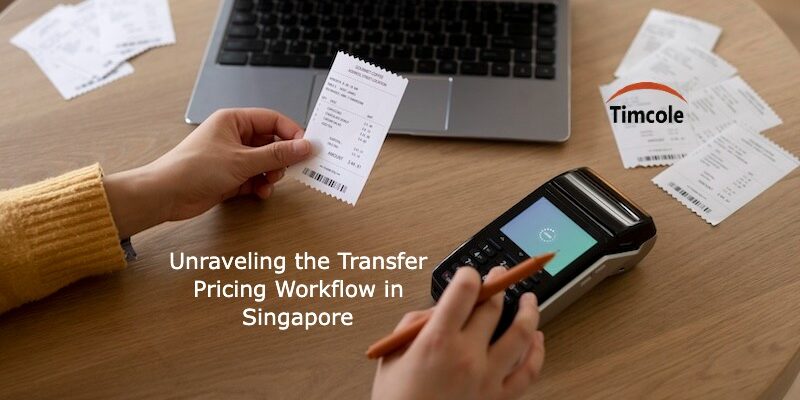Transfer pricing, often regarded as the backbone of international transactions within multinational corporations, plays a critical role in ensuring fair taxation and profit allocation across different jurisdictions. In Singapore, a global business hub known for its favourable tax policies and robust regulatory framework, understanding the workflow of transfer pricing is imperative for businesses aiming to navigate the complexities of cross-border transactions effectively.
In this blog post, we delve into the intricacies of transfer pricing in Singapore, exploring its significance, regulatory framework, and the essential steps involved in its workflow.
Significance of Transfer Pricing in Singapore
Singapore’s strategic location, business-friendly environment, and strong legal infrastructure have made it an attractive destination for company incorporation and multinational corporations (MNCs) seeking to expand their operations in Asia and beyond. As a result, the country witnesses a substantial volume of cross-border transactions, making transfer pricing a crucial aspect of its tax regime.
Transfer pricing ensures that transactions between related entities within an MNC are conducted at arm’s length, reflecting the fair market value, and thereby preventing profit shifting and tax evasion. By establishing transfer pricing regulations, Singapore aims to uphold transparency, prevent tax base erosion, and maintain its reputation as a trustworthy business hub.
Regulatory Framework
The regulatory framework governing transfer pricing in Singapore is primarily outlined by the Inland Revenue Authority of Singapore (IRAS). Key guidelines and regulations include:
- Singapore Transfer Pricing Guidelines: The IRAS provides comprehensive guidelines that align with the OECD Transfer Pricing Guidelines, offering clarity on various aspects such as the arm’s length principle, transfer pricing methods, documentation requirements, and dispute resolution mechanisms.
- Advance Pricing Arrangements (APAs): Businesses in Singapore can proactively engage with the IRAS to establish APAs, which provide certainty regarding transfer pricing outcomes for specific transactions over a defined period. This mechanism helps mitigate transfer pricing disputes and provides tax certainty for businesses.
- Transfer Pricing Documentation Requirements: Singapore requires businesses to maintain contemporaneous transfer pricing documentation to demonstrate compliance with arm’s length principles. This documentation typically includes functional analysis, economic analysis, and details of comparable transactions.
Workflow of Transfer Pricing in Singapore
The workflow of transfer pricing in Singapore involves several distinct steps, each crucial for ensuring compliance and mitigating risks:
Functional Analysis
The cornerstone of the transfer pricing workflow in Singapore begins with a meticulous functional analysis. Here, businesses embark on a comprehensive examination, delineating the functions undertaken, risks assumed, and assets utilized by entities participating in controlled transactions. By dissecting these elements, businesses gain invaluable insights into the dynamics of their intercompany dealings. This analysis serves as the bedrock for determining the most suitable transfer pricing method, laying the groundwork for subsequent steps in the process.
Selection of Transfer Pricing Method
Building upon the insights gleaned from the functional analysis, businesses proceed to select the most appropriate transfer pricing method. This decision-making process takes into account various factors such as comparability, data availability, and the inherent characteristics of the transactions in question. Among the array of methodologies available, including the comparable uncontrolled price (CUP) method, resale price method, cost-plus method, transactional profit split method and transactional net margin method (TNMM), the chosen approach should align closely with the specifics of the transactions and regulatory expectations.
Economic Analysis
Following the selection of the transfer pricing method, businesses undertake a comprehensive economic analysis to validate the arm’s length nature of the controlled transactions. This entails a rigorous benchmarking exercise, where transfer prices are compared against analogous transactions or entities to ascertain their conformity within an acceptable range of outcomes. Through this meticulous evaluation, businesses strive to ensure compliance with regulatory mandates and uphold the integrity of their transfer pricing practices.
Documentation and Compliance
Stringent regulatory requirements necessitate businesses to maintain robust transfer pricing documentation in alignment with Singapore’s regulations. This documentation serves as a vital record, meticulously documenting the rationale behind transfer pricing decisions and substantiating the arm’s length nature of the transactions. By adhering to documentation standards, businesses not only demonstrate compliance with regulatory obligations but also fortify their position in the event of scrutiny by tax authorities.
Transfer Pricing Compliance Review
Continuous vigilance is imperative in the realm of transfer pricing, necessitating periodic reviews and updates of policies and documentation. Through regular assessments, businesses can ensure ongoing compliance with regulatory mandates and adapt to changes in business operations or regulatory frameworks. This proactive approach enables businesses to fine-tune their transfer pricing strategies and safeguard against potential compliance pitfalls.
Resolution of Transfer Pricing Disputes
Despite meticulous adherence to regulations, transfer pricing disputes with tax authorities may arise. In such instances, businesses can leverage dialogue and negotiation as mechanisms to reach amicable resolutions. Proactive engagement, transparency, and cooperation are pivotal in navigating these disputes effectively, minimizing potential tax liabilities, and preserving the integrity of the transfer pricing process.
Conclusion
Transfer pricing is a critical consideration for businesses operating in Singapore’s dynamic business environment, given its significance in international tax compliance and risk management. By understanding the workflow of transfer pricing and adhering to regulatory requirements, businesses can enhance transparency, mitigate risks, and foster trust with tax authorities and stakeholders.
In navigating the intricacies of transfer pricing in Singapore, proactive engagement, robust documentation, and adherence to best practices are paramount. By prioritizing compliance and adopting sound transfer pricing strategies, businesses can optimize their tax outcomes while contributing to Singapore’s reputation as a trusted global business hub.
Engaging a corporate service provider in Singapore can significantly aid businesses in navigating the complexities of transfer pricing. These service providers possess expertise in regulatory compliance and transfer pricing methodologies, enabling businesses to leverage their knowledge and experience to ensure adherence to Singapore’s transfer pricing regulations.
Additionally, corporate service providers can assist in maintaining comprehensive documentation, conducting periodic compliance reviews, and facilitating communication with tax authorities, thereby streamlining the transfer pricing process and mitigating potential risks. By collaborating with a trusted corporate service provider, businesses can effectively manage their transfer pricing obligations, enhance efficiency, and focus on core business operations, ultimately bolstering their competitiveness in the global marketplace.








